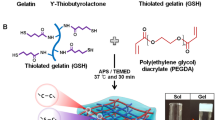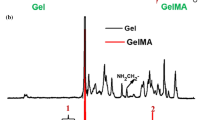Abstract
Polyethylene glycol-maleimide modified ε-polylysine (EPL-PEG-MAL) with a unique comb-shaped structure was designed and used as a novel crosslinker for thiolated chitosan (CSS). Novel polysaccharide/polypeptide bionic hydrogels based on CSS and EPL-PEG-MAL could form rapidly in situ within 1 min via Michael addition under physiological conditions. Rheological studies showed that introduction of PEG can dramatically improve the storage modulus (G′) of the hydrogels and the optimal hydrogel system showed superior G′ of 1,614 Pa. The maximum adhesion strength reached 148 kPa, six times higher than that of fibrin glue. Cytotoxicity test indicated that the hydrogel is nontoxic toward growth of L929 cells. Gelation time, swelling ratio, storage modulus and adhesion strength of the hydrogels can be modulated by the content of PEG-maleimide, CSS concentration and molar ratio of maleimide group to thiol group. Benefiting from the fast gelation behaviors, desirable mechanical properties, relatively high adhesive performance and no cytotoxicity, these hydrogels have the potential applications as promising biomaterials for tissue adhesion and sealing.





Similar content being viewed by others
References
Ishihara M, Nakanishi K, Ono K, Sato M, Kikuchi M, Saito Y, Yura H, Matsui T, Hattori H, Uenoyama M, Kurita A. Photocrosslinkable chitosan as a dressing for wound occlusion and accelerator in healing process. Biomaterials. 2002;23(3):833–40.
Ono K, Ishihara M, Ozeki Y, Deguchi H, Sato M, Saito Y, Yura H, Sato M, Kikuchi M, Kurita A, Maehara T. Experimental evaluation of photocrosslinkable chitosan as a biologic adhesive with surgical applications. Surgery. 2001;130(5):844–50.
Ogden S, Griffiths TW. A review of minimally invasive cosmetic procedures. Brit J Dermatol. 2008;159(5):1036–50.
Otani Y, Tabata Y, Ikada Y. Hemostatic capability of rapidly curable glues from gelatin, poly(l-glutamic acid), and carbodiimide. Biomaterials. 1998;19(22):2091–8.
Anseth KS, Metters AT, Bryant SJ, Martens PJ, Elisseeff JH, Bowman CN. In situ forming degradable networks and their application in tissue engineering and drug delivery. J Control Release. 2002;78(1–3):199–209.
Akgün A, Kuru S, Uraldi C, Tekin O, Karip B, Tug T, Öngören AU. Early effects of fibrin sealant on colonic anastomosis in rats: an experimental and case-control study. Tech Coloproctol. 2006;10(3):208–14.
Lee MGM, Jones D. Applications of fibrin sealant in surgery. Surg Innov. 2005;12(3):203–13.
Salameh JR, Schwartz JH, Hildebrandt DA. Can LigaSure seal and divide the small bowel. Am J Surg. 2006;191(6):791–3.
Saygun O, Topaloglu S, Avsar FM, Ozel H, Hucumenoglu S, Sahin M, Hengirmen S. Reinforcement of the suture line with an ePTFE graft attached with histoacryl glue in duodenal trauma. Can J Surg. 2006;49(2):107–12.
Thetter O. Fibrin adhesive and its application in thoracic surgery. Thorac Cardiovasc Surg. 1981;29(5):290–2.
Brennan M. Fibrin glue. Blood Rev. 1991;5:240–4.
Tseng YC, Tabata Y, Hyon SH, Ikada Y. In vivo toxicity test of 2-cyanoacrylate polymers by cell culture method. J Biomed Mater Res. 1990;24(10):1355–67.
Lämsä T, Jin HT, Sand J, Nordback I. Tissue adhesives and the pancreas: biocompatibility and adhesive properties of 6 preparations. Pancreas. 2008;36(3):261–6.
Lee Y, Chung HJ, Yeo S, Ahn CH, Lee H, Messersmith PB, Park TG. Thermo-sensitive, injectable, and tissue adhesive sol-gel transition hyaluronic acid/pluronic composite hydrogels prepared from bio-inspired catechol-thiol reaction. Soft Matter. 2010;6(5):977–83.
Masuko T, Minami A, Iwasaki N, Majima T, Nishimura SI, Lee YC. Thiolation of chitosan. Attachment of proteins via thioether formation. Biomacromolecules. 2005;6(2):880–4.
Fakhry A, Schneider GB, Zaharias R, Senel S. Chitosan supports the initial attachment and spreading of osteoblasts preferentially over fibroblasts. Biomaterials. 2004;25(11):2075–9.
Lauto A, Hook J, Doran M, Camacho F, Poole-Warren LA, Avolio A, Foster LJR. Chitosan adhesive for laser tissue repair: in vitro characterization. Laser Surg Med. 2005;36(3):193–201.
Ono K, Saito Y, Yura H, Ishikawa K, Kurita A, Akaike T, Ishihara M. Photocrosslinkable chitosan as a biological adhesive. J Biomed Mater Res. 2000;49(2):289–95.
Yamada K, Chen TH, Kumar G, Vesnovsky O, Topoleski LDT, Payne GF. Chitosan based water-resistant adhesive. Analogy to mussel glue. Biomacromolecules. 2000;1(2):252–8.
Yamada K, Aoki T, Ikeda N, Hirata M. Application of enzymatically gelled chitosan solutions to water-resistant adhesives. J Appl Polym Sci. 2007;104(3):1818–27.
Vernon B, Tirelli N, Bächi T, Haldimann D, Hubbell JA. Water-borne, in situ crosslinked biomaterials from phase-segregated precursors. J Biomed Mater Res. 2003;64A(3):447–56.
Teng DY, Wu ZM, Zhang XG, Wang YX, Zheng C, Wang Z, Li CX. Synthesis and characterization of in situ cross-linked hydrogel based on self-assembly of thiol-modified chitosan with PEG diacrylate using Michael type addition. Polymer. 2010;51(3):639–46.
Patterson J, Hubbell JA. SPARC-derived protease substrates to enhance the plasmin sensitivity of molecularly engineered PEG hydrogels. Biomaterials. 2011;32(5):1301–10.
Hermanson GT. Bioconjugate techniques. 2nd ed. San Diego: Academic Press; 1996.
Phelps EA, Enemchukwu NO, Fiore VF, Sy JC, Murthy N, Sulchek TA, Barker TH, García AJ. Maleimide cross-linked bioactive PEG hydrogel exhibits improved reaction kinetics and cross-linking for cell encapsulation and in situ delivery. Adv Mater. 2012;24(1):64–70.
Krauland AH, Hoffer MH, Bernkop-Schnürch A. Viscoelastic properties of a new in situ gelling thiolated chitosan conjugate. Drug Dev Ind Pharm. 2005;31(9):885–93.
Shih IL, Shen MH, Van YT. Microbial synthesis of poly(ε-lysine) and its various applications. Bioresource Technol. 2006;97(9):1148–59.
Gupta D, Tator CH, Shoichet MS. Fast-gelling injectable blend of hyaluronan and methylcellulose for intrathecal, localized delivery to the injured spinal cord. Biomaterials. 2006;27(11):2370–9.
Wang T, Nie J, Yang DZ. Dextran and gelatin based photocrosslinkable tissue adhesive. Carbohydr Polym. 2012;90(4):1428–36.
Li HB, Niu R, Yang JL, Nie J, Yang DZ. Photocrosslinkable tissue adhesive based on dextran. Carbohydr Polym. 2011;86(4):1578–85.
Singh R. A sensitive assay for maleimide groups. Bioconjugate Chem. 1994;5(4):348–51.
Yang C, Xu L, Zhou Y, Zhang XM, Huang X, Wang M, Han Y, Zhai ML, Wei SC, Li JQ. A green fabrication approach of gelatin/CM-chitosan hybrid hydrogel for wound healing. Carbohydr Polym. 2010;82(4):1297–305.
Artzi N, Shazly T, Crespo C, Ramos AB, Chenault HK, Edelman ER. Characterization of star adhesive sealants based on PEG/dextran hydrogels. Macromol Biosci. 2009;9(8):754–65.
Lutolf MP, Hubbell JA. Synthesis and physicochemical characterization of end-linked poly(ethylene glycol)-co-peptide hydrogels formed by Michael-type addition. Biomacromolecules. 2003;4:713–22.
Sun JY, Zhao XH, Illeperuma WRK, Chaudhuri O, Oh KH, Mooney DJ, Vlassak JJ, Suo ZG. Highly stretchable and tough hydrogels. Nature. 2012;489:133–6.
Naficy S, Brown HR, Razal JM, Spinks GM, Whitten PG. Progress toward robust polymer hydrogels. Aust J Chem. 2011;64(8):1007–25.
Takaoka M, Nakamura T, Sugai H, Bentley AJ, Nakajima N, Fullwood NJ, Yokoi N, Hyon SH, Kinoshita S. Sutureless amniotic membrane transplantation for ocular surface reconstruction with a chemically defined bioadhesive. Biomaterials. 2008;29(19):2923–31.
Hiemstra C, Van der Aa LJ, Zhong ZY, Dijkstra PJ, Feijen J. Rapidly in situ-forming degradable hydrogels from dextran thiols through Michael addition. Biomacromolecules. 2007;8(5):1548–56.
Buwalda SJ, Dijkstra PJ, Feijen J. In situ forming poly(ethylene glycol)-poly(l-lactide) hydrogels via Michael addition: mechanical properties, degradation, and protein release. Macromol Chem Phys. 2012;213:766–75.
Tournier EJM, Wallach J, Blond P. Sulfosuccinimidyl 4-(N-maleimidomethyl)-1-cyclohexane carboxylate as a bifunctional immobilization agent. Optimization of the coupling conditions. Anal Chim Acta. 1998;361(1–2):33–44.
Mather BD, Viswanathan K, Miller KM, Long TE. Michael addition reactions in macromolecular design for emerging technologies. Prog Polym Sci. 2006;31(5):487–531.
Nie W, Yuan XY, Zhao J, Zhou YL, Bao HJ. Rapidly in situ forming chitosan/ε-polylysine hydrogels for adhesive sealants and hemostatic materials. Carbohydr Polym. 2013;96:342–8.
Serrero A, Trombotto S, Bayon Y, Gravagna P, Montanari S, David L. Polysaccharide-based adhesive for biomedical applications: correlation between rheological behavior and adhesion. Biomacromolecules. 2011;12(5):1556–66.
Bernkop-Schnürch A, Weithaler A, Albrecht K, Greimel A. Thiomers: preparation and in vitro evaluation of a mucoadhesive nanoparticulate drug delivery system. Int J Pharm. 2006;317(1):76–81.
Li ZH, DZ Y, Ma GP, Xu Q, Chen XM, Lu FM, Nie J. Synthesis and characterization of chitosan-based hydrogels. Int J Biol Macromol. 2009;44:121–7.
Rabea EI, Badawy MET, Stevens CV, Smagghe G, Steurbaut W. Chitosan as antimicrobial agent: applications and mode of action. Biomacromolecules. 2003;4(6):1457–65.
Acknowledgments
The authors gratefully acknowledge the support for this research from the National Natural Science Foundation of China (Grant 51103095).
Author information
Authors and Affiliations
Corresponding author
Electronic supplementary material
Below is the link to the electronic supplementary material.
Rights and permissions
About this article
Cite this article
Zhou, Y., Nie, W., Zhao, J. et al. Rapidly in situ forming adhesive hydrogel based on a PEG-maleimide modified polypeptide through Michael addition. J Mater Sci: Mater Med 24, 2277–2286 (2013). https://doi.org/10.1007/s10856-013-4987-1
Received:
Accepted:
Published:
Issue Date:
DOI: https://doi.org/10.1007/s10856-013-4987-1




